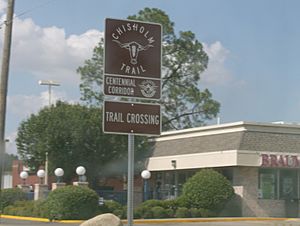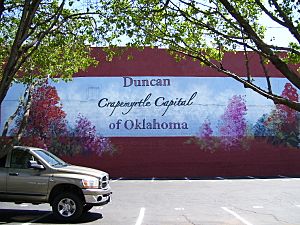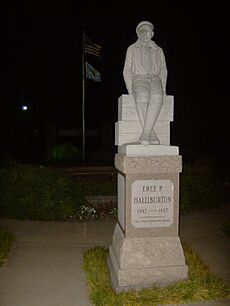Duncan, Oklahoma facts for kids
Quick facts for kids
Duncan, Oklahoma
|
|
|---|---|
|
City
|
|
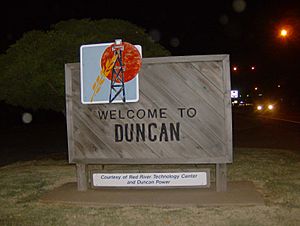 |
|
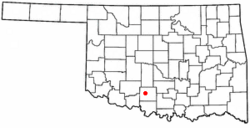
Location of Duncan, Oklahoma
|
|
| Country | United States |
| State | Oklahoma |
| County | Stephens |
| Area | |
| • Total | 47.84 sq mi (123.89 km2) |
| • Land | 42.95 sq mi (111.24 km2) |
| • Water | 4.88 sq mi (12.65 km2) |
| Elevation | 1,211 ft (369 m) |
| Population
(2020)
|
|
| • Total | 22,692 |
| • Density | 528.31/sq mi (203.98/km2) |
| Time zone | UTC−6 (Central (CST)) |
| • Summer (DST) | UTC−5 (CDT) |
| ZIP codes |
73533-73599
|
| Area code(s) | 580 |
| FIPS code | 40-21900 |
| GNIS feature ID | 2410368 |
Duncan is a city in Stephens County, Oklahoma, United States. It is the main city and the county seat of Stephens County. In 2020, about 22,310 people lived there. Duncan became the county seat when Oklahoma became a state in 1907.
The city grew quickly after oil wells opened nearby in 1918. Even though cotton farming declined, raising cattle is still a big part of the local economy. The famous Chisholm Trail passed close to Duncan before the city was even founded. Today, you can visit the Chisholm Trail Heritage Center in Duncan.
Duncan is also known as the birthplace of the Halliburton Corporation. This big company was started by Erle P. Halliburton in 1919. He created a new way to cement oil wells. Halliburton still has several buildings and a park in Duncan.
Contents
History of Duncan
How Duncan Began
Before Duncan existed, the Chisholm Trail was a busy path for moving cattle. Millions of Longhorn cattle were herded along this trail from Texas to Kansas. In 1892, a man named William Duncan learned that a railroad was coming through. He decided to set up a trading post where the Chisholm Trail crossed a military road.
The first train arrived on June 27, 1892. This date is celebrated as the official start of Duncan. Many early buildings were made of wood. But after fires, they were rebuilt with stronger stone and brick.
Duncan in the 20th Century
In 1901, several fires caused damage to the growing town. When Oklahoma became a state in 1907, Duncan was chosen as the county seat. This was a fair choice because it was in the middle of Stephens County. The county courthouse was even built right in the center of Main Street.
In 1918, oil wells were discovered in Stephens County. This brought a lot of growth and new people to Duncan. The city made rules to help manage this fast growth.
During the 1930s, after the Great Depression, the government helped build new things. These projects included a public library, a high school, a stadium, and a swimming pool. They also built an armory and many bridges and sidewalks. Duncan continued to grow during World War II.
Geography and Climate
Where is Duncan?
Duncan is about 30 miles east of Lawton. It is also about 80 miles south of Oklahoma City. The city covers about 46 square miles, with some of that area being water.
Duncan is famous for its beautiful crape myrtle trees. Because of this, state lawmakers named it Oklahoma's official "Crape Myrtle Capital." The area also has wide-open grasslands, which are part of the Great Plains. There are four lakes near the city.
Weather in Duncan
Duncan gets about 34 inches of rain each year. It also gets about five inches of snow. The city enjoys around 241 sunny days every year. Duncan is located about 1,128 feet above sea level.
| Climate data for Duncan, Oklahoma | |||||||||||||
|---|---|---|---|---|---|---|---|---|---|---|---|---|---|
| Month | Jan | Feb | Mar | Apr | May | Jun | Jul | Aug | Sep | Oct | Nov | Dec | Year |
| Record high °F (°C) | 84 (29) |
88 (31) |
97 (36) |
96 (36) |
99 (37) |
106 (41) |
110 (43) |
110 (43) |
108 (42) |
101 (38) |
90 (32) |
88 (31) |
110 (43) |
| Mean daily maximum °F (°C) | 52 (11) |
57 (14) |
65 (18) |
76 (24) |
82 (28) |
90 (32) |
95 (35) |
96 (36) |
89 (32) |
78 (26) |
64 (18) |
55 (13) |
75 (24) |
| Mean daily minimum °F (°C) | 29 (−2) |
33 (1) |
40 (4) |
51 (11) |
59 (15) |
68 (20) |
71 (22) |
71 (22) |
64 (18) |
53 (12) |
39 (4) |
32 (0) |
51 (11) |
| Record low °F (°C) | −8 (−22) |
−3 (−19) |
2 (−17) |
26 (−3) |
34 (1) |
49 (9) |
55 (13) |
56 (13) |
36 (2) |
26 (−3) |
14 (−10) |
5 (−15) |
−8 (−22) |
| Average precipitation inches (mm) | 1.4 (36) |
1.8 (46) |
2.0 (51) |
3.0 (76) |
6.4 (160) |
4.5 (110) |
2.7 (69) |
2.4 (61) |
2.5 (64) |
3.4 (86) |
1.5 (38) |
1.5 (38) |
33.1 (835) |
| Average snowfall inches (cm) | 2 (5.1) |
2.2 (5.6) |
1 (2.5) |
0.3 (0.76) |
— | — | — | — | — | — | — | 1.5 (3.8) |
7 (18) |
| Average rainy days | 3.5 | 4.3 | 4.8 | 6.1 | 7.6 | 7.3 | 5.2 | 4.8 | 4.3 | 5.5 | 2.9 | 3.8 | 60.1 |
| Average relative humidity (%) | 70 | 67 | 61 | 60 | 68 | 65 | 63 | 58 | 58 | 63 | 63 | 66 | 64 |
| Source 1: weather.com | |||||||||||||
| Source 2: Weatherbase.com | |||||||||||||
People of Duncan
| Historical population | |||
|---|---|---|---|
| Census | Pop. | %± | |
| 1900 | 1,164 | — | |
| 1910 | 2,477 | 112.8% | |
| 1920 | 3,463 | 39.8% | |
| 1930 | 8,363 | 141.5% | |
| 1940 | 9,207 | 10.1% | |
| 1950 | 15,325 | 66.4% | |
| 1960 | 20,009 | 30.6% | |
| 1970 | 19,718 | −1.5% | |
| 1980 | 22,517 | 14.2% | |
| 1990 | 21,732 | −3.5% | |
| 2000 | 22,505 | 3.6% | |
| 2010 | 23,431 | 4.1% | |
| 2020 | 22,692 | −3.2% | |
| Sources: | |||
Population Details
In 2010, there were 23,431 people living in Duncan. There were 9,535 households in the city. About 82.3% of the people were White. Other groups included African American, Native American, and people of two or more races. About 8.9% of the population was Hispanic or Latino.
The average household had about 2.41 people. About 23.8% of the population was under 18 years old. About 17.9% of the people were 65 or older. The average income for a household was $39,683.
Duncan's Economy
Duncan used to have the slogan, "The Buckle on the Oil Belt." This shows how important the oil business was to the city. The most famous company from Duncan is Halliburton. Erle P. Halliburton started his oil well cementing company in 1919. His new method made it much easier to get oil from the ground.
When Erle P. Halliburton passed away in 1957, his company had offices all over the world. Halliburton still has several buildings in Duncan. They also have a special technology center there.
Farming has always been important to Duncan's economy. Cotton used to be a major crop. But after the Dust Bowl, its role became smaller. Today, raising cattle is still a very important part of Duncan's economy. The city has also had many banks and doctors since it first started.
Arts and Fun in Duncan
Local Culture and Attractions
Duncan is home to the Chisholm Trail Heritage Center. This center has many exhibits about the famous trail. You can see a huge bronze statue called On the Chisholm Trail. It shows cowboys and cattle on the move. You can even see real traces of old cattle hoofs and wagon wheels at Monument Hill.
The Stephens County Historical Museum shows items from the early days of the area. It is located in an old National Guard Armory building. This building was built in the 1930s as a project to help the economy.
Annual Events
Duncan hosts many fun events throughout the year. There is an annual county fair with livestock shows. Other events include:
- The Chisholm Trail Arts Council's Art Walk
- The Trail Dance Film Festival
- The Cruizin' the Chisholm Trail Car and Motorcycle Show
- The Chisholm Trail Stampede
- The Dehydrator bicycle race
- Summerfest, which includes the World's Largest Garage Sale
- The Western Spirit Celebration
Parks and Outdoor Activities
Duncan has many parks for everyone to enjoy. Some of the city parks include:
- Abe Raizen Park (baseball, soccer, playground)
- Arboretum and Heritage Park (walking path, plants)
- Douglass Park (splash pad, playground, tennis courts)
- Fuqua Park (swimming pool, playground, museum, train exhibit)
- Memorial Park (war memorials, tennis courts)
There are also several lakes nearby for outdoor fun. These include Lake Humphreys, Clear Creek Lake, Fuqua Lake, and Duncan Lake. The Wichita Mountains Wildlife Refuge is also not far away.
Historic Buildings
Duncan has many buildings that are listed on the National Register of Historic Places. These are important places that are protected for their history. Eight of the 10 historic places in Stephens County are in Duncan. Some examples include the Brittain-Garvin House and the Duncan Public Library.
Education in Duncan
Students in Duncan attend schools run by Duncan Public Schools. For career training, students can go to the Red River Technology Center. Cameron University also has a branch campus in Duncan.
Newspapers
The main newspaper in Duncan today is The Duncan Banner. It started publishing in 1892.
Transportation
Duncan is served by major roads like U.S. Route 81 and State Highway 7. The city also has an airport called Halliburton Field. It has a long paved runway for planes.
Famous People from Duncan
Many notable people have come from Duncan, including:
- Jari Askins (born 1953) – Former Lt. Governor of Oklahoma
- Hoyt Axton (1938–1999) – Country music singer-songwriter
- Erle P. Halliburton (1892–1957) – Founder of Halliburton Oil Well Cementing Company
- Rance Howard (1928–2017) – Actor
- Ron Howard (born 1954) – Famous actor, director, and producer
- Jeane Kirkpatrick (1926–2006) – Former United States ambassador to the United Nations
- Jackie Sherrill (born 1943) – Former college football head coach
See also
 In Spanish: Duncan (Oklahoma) para niños
In Spanish: Duncan (Oklahoma) para niños


